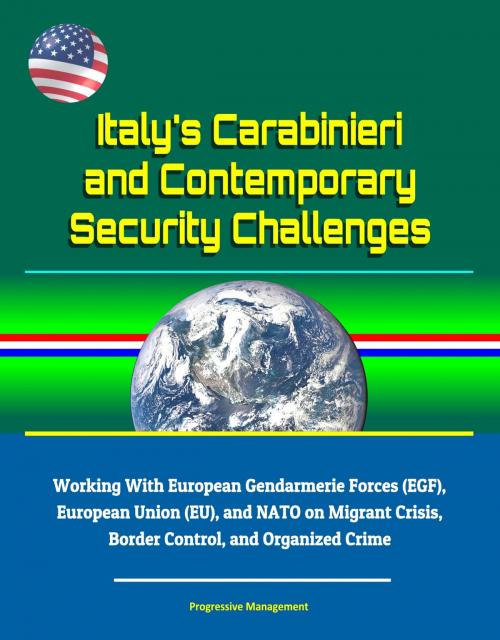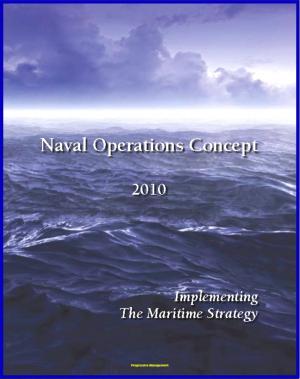Italy's Carabinieri and Contemporary Security Challenges - Working With European Gendarmerie Forces (EGF), European Union (EU), and NATO on Migrant Crisis, Border Control, and Organized Crime
Nonfiction, History, Western Europe, Italy| Author: | Progressive Management | ISBN: | 9780463794791 |
| Publisher: | Progressive Management | Publication: | July 6, 2018 |
| Imprint: | Smashwords Edition | Language: | English |
| Author: | Progressive Management |
| ISBN: | 9780463794791 |
| Publisher: | Progressive Management |
| Publication: | July 6, 2018 |
| Imprint: | Smashwords Edition |
| Language: | English |
This important December 2017 report has been professionally converted for accurate flowing-text e-book format reproduction.
Since its founding in 1814 as a police force in the Kingdom of Sardinia, the Italian Carabinieri has demonstrated success. To meet contemporary security challenges, the Italian Carabinieri has adapted its police and military capacities to address both internal and external threats while working together with the European Gendarmerie Forces (EGF), the European Union (EU), and the North Atlantic Treaty Organization (NATO). Because of the magnitude of certain contemporary security challenges, specifically the migrant crisis and organized crime, Italy has continued to struggle with border control due to the country's long coastlines and relatively close proximity to other nations. This thesis highlights the role of the Italian Carabinieri's historical success and analyzes its contributions to EGF, EU, and NATO effectiveness in addressing contemporary security challenges.
The Italian Carabinieri was established in 1814 to provide local police forces within each province in what was then the Kingdom of Sardinia. It has grown into a classic gendarmerie, a national law enforcement agency that, since 2000, has been formally part of the Italian Ministry of Defense. The Carabinieri serves Italy as both a military force and a police force with special duties and prerogatives.
As Italy has evolved over the centuries, the Carabinieri has grown and adapted to emerging security challenges. For example, more than half a million migrants, particularly those fleeing from Africa and the Middle East, entered Italy between 2014 and 2016, as compared to a total of 119,000 in the three previous years — a figure that included the wave of refugees from the 2011 war in Libya. At the same time, perhaps also because of Italy's long coastlines and relative proximity to certain source nations, human trafficking in Italy accounts for 25 percent of the total in the European Union (EU). In the meantime, organized crime in Italy has grown to epic proportions, encompassing money laundering, counterfeiting, corruption, and drug trafficking. In addition, terrorism poses a growing threat around the world; and it requires vigilant force to monitor, predict, and prevent terrorist activity.
I. INTRODUCTION * A. SIGNIFICANCE OF THE RESEARCH QUESTIONS * B. LITERATURE REVIEW * C. POTENTIAL EXPLANATIONS AND HYPOTHESES * D. RESEARCH DESIGN * E. THESIS OVERVIEW * II. HISTORY * A. ORGANIZATION OF THE CARABINIERI * B. PRESENT SECURITY CHALLENGES OF THE CARABINIERI * III. EUROPEAN GENDARMERIE FORCES, EUROPEAN UNION, AND NORTH ATLANTIC TREATY ORGANIZATION * A. EUROPEAN GENDARMERIE FORCES * B. ORGANIZATION AND FUNCTION OF THE EGF * C. EUROPEAN UNION * D. NORTH ATLANTIC TREATY ORGANIZATION * IV. ITALIAN CARABINIERI RESPONSE TO CONTEMPORARY SECURITY CHALLENGES * A. ORGANIZED CRIME * B. MIGRANT CRISIS * 1. The Stance of the EU and NATO * 2. The Case of Libya * 3. Frontex Joint Operation Triton * V. CONCLUSION: SECURITY IMPLICATIONS * A. INSIDE ITALY'S BORDERS * B. BORDER CONTROL * C. EUROPEAN GENDARMERIE FORCE * D. EUROPEAN UNION AND NATO
This important December 2017 report has been professionally converted for accurate flowing-text e-book format reproduction.
Since its founding in 1814 as a police force in the Kingdom of Sardinia, the Italian Carabinieri has demonstrated success. To meet contemporary security challenges, the Italian Carabinieri has adapted its police and military capacities to address both internal and external threats while working together with the European Gendarmerie Forces (EGF), the European Union (EU), and the North Atlantic Treaty Organization (NATO). Because of the magnitude of certain contemporary security challenges, specifically the migrant crisis and organized crime, Italy has continued to struggle with border control due to the country's long coastlines and relatively close proximity to other nations. This thesis highlights the role of the Italian Carabinieri's historical success and analyzes its contributions to EGF, EU, and NATO effectiveness in addressing contemporary security challenges.
The Italian Carabinieri was established in 1814 to provide local police forces within each province in what was then the Kingdom of Sardinia. It has grown into a classic gendarmerie, a national law enforcement agency that, since 2000, has been formally part of the Italian Ministry of Defense. The Carabinieri serves Italy as both a military force and a police force with special duties and prerogatives.
As Italy has evolved over the centuries, the Carabinieri has grown and adapted to emerging security challenges. For example, more than half a million migrants, particularly those fleeing from Africa and the Middle East, entered Italy between 2014 and 2016, as compared to a total of 119,000 in the three previous years — a figure that included the wave of refugees from the 2011 war in Libya. At the same time, perhaps also because of Italy's long coastlines and relative proximity to certain source nations, human trafficking in Italy accounts for 25 percent of the total in the European Union (EU). In the meantime, organized crime in Italy has grown to epic proportions, encompassing money laundering, counterfeiting, corruption, and drug trafficking. In addition, terrorism poses a growing threat around the world; and it requires vigilant force to monitor, predict, and prevent terrorist activity.
I. INTRODUCTION * A. SIGNIFICANCE OF THE RESEARCH QUESTIONS * B. LITERATURE REVIEW * C. POTENTIAL EXPLANATIONS AND HYPOTHESES * D. RESEARCH DESIGN * E. THESIS OVERVIEW * II. HISTORY * A. ORGANIZATION OF THE CARABINIERI * B. PRESENT SECURITY CHALLENGES OF THE CARABINIERI * III. EUROPEAN GENDARMERIE FORCES, EUROPEAN UNION, AND NORTH ATLANTIC TREATY ORGANIZATION * A. EUROPEAN GENDARMERIE FORCES * B. ORGANIZATION AND FUNCTION OF THE EGF * C. EUROPEAN UNION * D. NORTH ATLANTIC TREATY ORGANIZATION * IV. ITALIAN CARABINIERI RESPONSE TO CONTEMPORARY SECURITY CHALLENGES * A. ORGANIZED CRIME * B. MIGRANT CRISIS * 1. The Stance of the EU and NATO * 2. The Case of Libya * 3. Frontex Joint Operation Triton * V. CONCLUSION: SECURITY IMPLICATIONS * A. INSIDE ITALY'S BORDERS * B. BORDER CONTROL * C. EUROPEAN GENDARMERIE FORCE * D. EUROPEAN UNION AND NATO















